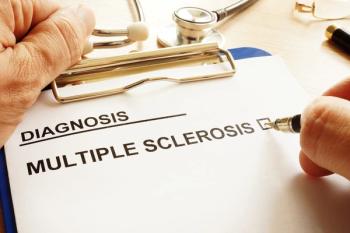
Double-Blinded Extension of the RADIANCE Trial Demonstrates the Efficacy and Safety of Ozanimod in Patients With Multiple Sclerosis
Background
Sphingosine 1-phosphate (S1P) is a phospholipid that is involved in many biological processes, including lymphocyte migration. Fingolimod, the first S1P receptor modulator approved for treating relapsing multiple sclerosis (MS), nonselectively targets 4 of the 5 S1P receptors: S1P1, S1P3, S1P4, and S1P5. Modulation of S1P1 prevents immune cells from entering circulation, whereas antagonism of S1P5 may promote neuronal protection. Ozanimod is a S1P receptor modulator that selectively targets S1P1 and S1P5.1
The efficacy and safety of ozanimod in patients with relapsing MS were evaluated in the RADIANCE trial. In part A of the phase II, randomized, placebo-controlled RADIANCE trial, both doses of ozanimod (0.5 mg and 1 mg) significantly reduced the mean cumulative number of gadolinium (Gd)-enhancing lesions and new or enlarging T2-hyperintense lesions over 12 to 24 weeks compared with placebo. Dose-dependent decreases in annualized relapse rate (ARR) were also observed. There were no reports of serious cardiac events, serious infections, or macular edema during part A of the trial.1
Methods
Patients who completed part A of the RADIANCE trial were eligible to participate in the dose-blinded extension study. During the extension phase, patients originally randomized to ozanimod continued their assigned dose; patients originally randomized to placebo were re-randomized 1:1 to receive either ozanimod 0.5 mg or ozanimod 1 mg.1
Patients were evaluated every 12 weeks during the extension study. Magnetic resonance imaging (MRI) scans were performed at extension study entry, 6 months, 1 year, and 2 years. Efficacy end points included mean number of Gd-enhancing lesions, percentage of patients free of Gd-enhancing lesions, mean number of new or enlarging T2-hyperintense lesions on brain MRI, and unadjusted ARR. Safety was also assessed. Treatment-emergent adverse events (AEs) of special interest that were assessed in the extension study included infections, bradycardia, cardiac conduction abnormalities, abnormal pulmonary function tests, macular edema, hepatic effects, and malignancies.1
Results
Patient Demographics
In the extension phase of the RADIANCE trial, patient demographics and disease characteristics were similar across treatment groups and similar to those observed in the placebo-controlled portion of the trial. Upon entry into the blinded extension, 58.5% to 87.7% of patients were free of Gd-enhancing lesions (84.7%, ozanimod 0.5 mg to ozanimod 0.5 mg; 87.7%, ozanimod 1 mg to ozanimod 1 mg; 58.5%, placebo to ozanimod 0.5 mg; 69%, placebo to ozanimod 1 mg).1
During the extension phase, 126 patients received 0.5-mg doses of ozanimod and 123 patients received 1-mg doses of ozanimod. Overall, 89.6% of patients (223 of 249) completed the 2-year blinded extension.1
Efficacy
At year 1, 91.1% to 92.9% of patients were free of Gd-enhancing lesions; at year 2, 86.5% to 94.6% of patients were free of Gd-enhancing lesions. A dose-dependent trend in reduction in the mean number of new or enlarging T2 lesions was observed with ozanimod from the start of the extension phase to year 1 and from year 1 to year 2. Unadjusted ARRs, which ranged from 0.18 to 0.32 in the extension phase, were maintained in patients who received ozanimod during both the placebo-controlled trial and the extension phase and were decreased for patients who received placebo during the placebo-controlled trial and received ozanimod during the extension phase. Mean Expanded Disability Status Scale scores remained stable.1
Safety
During the extension phase, no unexpected safety signals were observed. The most commonly reported treatment-emergent AEs included nasopharyngitis, upper respiratory tract infections, and increased alanine aminotransferase (ALT) levels. Twelve patients experienced increases in ALT levels of at least 3 times the upper limit of normal (ozanimod 0.5 mg, n = 4; ozanimod 1 mg, n = 8). Two patients had concurrent increases in aspartate aminotransferase (AST) levels (ozanimod 0.5 mg, n = 1; ozanimod 1 mg, n = 1) and 1 patient who received ozanimod 1 mg had an isolated elevation in AST level. During the blinded extension, there were no reports of serious opportunistic infections, significant abnormalities in pulmonary function tests, macular edema, malignancies, or second-degree or higher atrioventricular block.1
Twenty-six patients discontinued treatment before the end of the 2-year extension phase (14 patients randomized to ozanimod 0.5 mg and 12 patients randomized to ozanimod 1 mg). Reasons for discontinuation of ozanimod 0.5 mg were AEs (n = 3), physician decision (n = 4), protocol violation (n = 1), and voluntary withdrawal (n = 6). Reasons for discontinuation of ozanimod 1 mg were AEs (n = 2), lack of efficacy (n = 4), protocol violation (n = 2), and voluntary withdrawal (n = 4). Four of the discontinuations due to AEs were specified by the trial protocol and were due to increased transaminase levels. These patients recovered after ozanimod use was discontinued.1
Conclusion
The efficacy of both doses of ozanimod (0.5 mg and 1 mg) observed in the placebo-controlled RADIANCE trial was maintained in the 2-year blinded extension. Low levels of MRI lesion activity, specifically the presence of Gd-enhancing lesions, and low unadjusted ARRs were observed during the blinded extension. Greater efficacy on both MRI and clinical disease measures was observed with ozanimod 1 mg compared with ozanimod 0.5 mg.
Reference
1. Cohen JA, Comi G, Arnold DL, et al; RADIANCE Trial Investigators. Efficacy and safety of ozanimod in multiple sclerosis: dose-blinded extension of a randomized phase II study [published online July 25, 2018]. Mult Scler. 2018:1352458518789884. doi: 10.1177/1352458518789884.
Newsletter
Stay ahead of policy, cost, and value—subscribe to AJMC for expert insights at the intersection of clinical care and health economics.















































